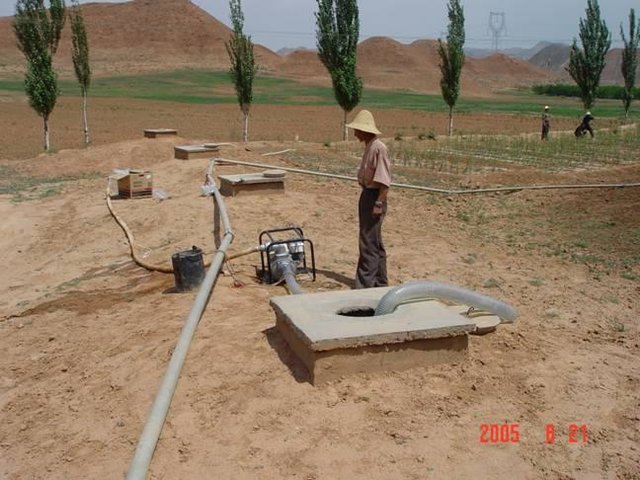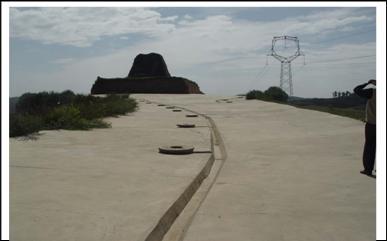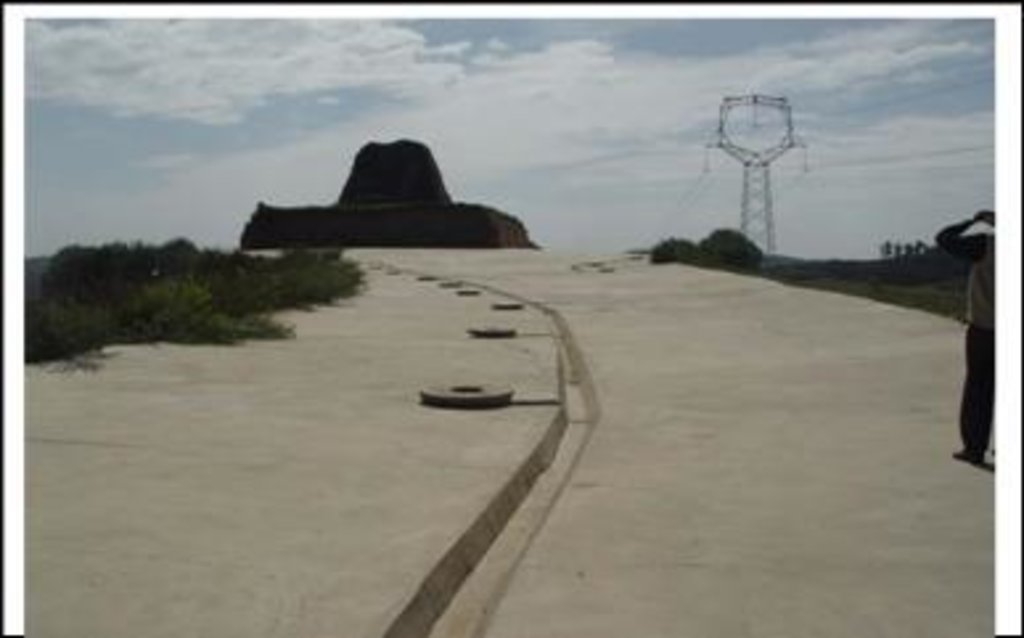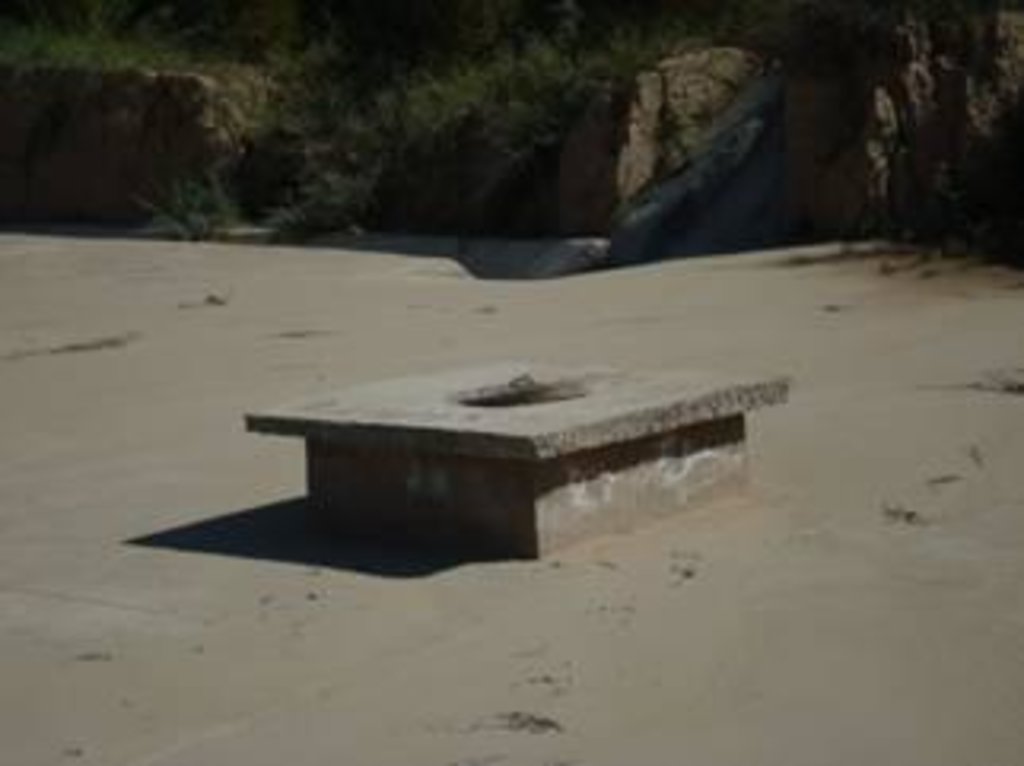Rainwater Cellars [จีน]
- ผู้สร้างสรรค์:
- การอัพเดท:
- ผู้รวบรวม: Anna Schuler
- ผู้เรียบเรียง: –
- ผู้ตรวจสอบ: Deborah Niggli, Alexandra Gavilano
technologies_1335 - จีน
ดูส่วนย่อย
ขยายทั้งหมด ย่อทั้งหมด1. ข้อมูลทั่วไป
1.2 รายละเอียดที่ติดต่อได้ของผู้รวบรวมและองค์กรที่เกี่ยวข้องในการประเมินและการจัดเตรียมทำเอกสารของเทคโนโลยี
ชื่อของโครงการซึ่งอำนวยความสะดวกในการทำเอกสารหรือการประเมินเทคโนโลยี (ถ้าเกี่ยวข้อง)
Best Practices for Land Degradation Control in Dryland Areas of China (Best Practices China)1.3 เงื่อนไขการใช้ข้อมูลที่ได้บันทึกผ่านทาง WOCAT
ผู้รวบรวมและวิทยากรหลักยอมรับเงื่อนไขเกี่ยวกับการใช้ข้อมูลที่ถูกบันทึกผ่านทาง WOCAT:
ใช่
1.4 การเปิดเผยเรื่องความยั่งยืนของเทคโนโลยีที่ได้อธิบายไว้
เทคโนโลยีที่ได้อธิบายไว้นี้เป็นปัญหาของความเสื่อมโทรมโทรมของที่ดินหรือไม่ จึงไม่ได้รับการยอมรับว่าเป็นเทคโนโลยีเพื่อการจัดการที่ดินอย่างยั่งยืน:
ไม่ใช่
1.5 Reference to Questionnaire(s) on SLM Approaches (documented using WOCAT)

Rainwater Cellars introduced through government support [จีน]
Government takes the lead and propelled by project, the rainwater collection for irrigation technology scales up by demonstration.
- ผู้รวบรวม: Anna Schuler
2. การอธิบายลักษณะของเทคโนโลยี SLM
2.1 การอธิบายแบบสั้น ๆ ของเทคโนโลยี
คำจำกัดความของเทคโนโลยี:
The use of courtyard, roof, road surface, slope, etc. as catchments to collect rainwater for underground water storage for future supply of cropland irrigation as well as drinking water for humans and livestock.
2.2 การอธิบายแบบละเอียดของเทคโนโลยี
คำอธิบาย:
The demonstration site is located in mid Gansu, semi-arid gully area of the Loess Plateau, where either surface or groundwater is in great shortage. The annual precipitation is around 380mm with 60% concentrated in July, August and September in storm form. Due to scarce vegetation and serious soil erosion. The agricultural farming is rainfed, but the timing of precipitation and water demand of crops do not coincide, so that the rainwater utilization is extremely low. Low productivity of land and shortage of water for mankind and animal leads to poverty. Since 1980s the government has organized local people in mid Gansu to explore the utilization of water cellars to achieve coincided precipitation, i.e. collecting rainwater to solve water shortage and develop dryland crop cultivation.
Water cellars are used mainly for the interception of rainwater to supply water for humans and livestock as well as for the irrigation of crops. The cellar is comprised of the cellar body and an ancillary facility, including catchment area, delivery facility (ditch, silt tank, stain interception grate, inlet pipe, cellar opening and irrigation equipment). In general, water cellars are designed to 20-30m3 in capacity. The catchment should be chosen at hillside, road surface, courtyard, roofing, greenhouse roof, etc. For the location selection, considerations should be given to site landform and geological conditions and not proximity to ditch or trench banks, large tree stumps but close to farmland to maximize the possibility of self-flowing irrigation. In consideration of drinking water safety, the cellar should be built far from livestock sheds and toilets to prevent contamination. The silt tank is 2-3m wide, 1m deep and 2-3m away from the cellar opening, and higher than water cellar inlet. The dirt interception grate should be installed 0.5m higher than the base of the silt tank pond and upstream of the inlet. The platform of the water cellar should be 0.3-0.5m high above ground. In Anding District, the concrete cement sphere type water cellar is more often adopted, with the cellar vault/wall of 10cm and base of 20cm thick. At the demonstration site, the inner wall used to be lined with red puddle. Now concrete cement is used for the base and lined with cement and mortar. The water for irrigation does not need special treatment, but drinking water does. Irrigation is done by pumping for watering by ditches flowing to the farmland, hole watering or drip irrigation.
Since mid 1990s, the water cellar has expanded gradually. The 1-2-1 rainwater collection project (each household has 1 catchment, 2 water cellars and 1 patch of courtyard cashcrop forest) has played a significant role in the technology dissemination and poverty alleviation. Since 2000, water cellar function has been further extended toward multifunction for livestock raising, farmland/forest land irrigation and so forth, and greater economic and social benefits are captured by its combination with greenhouse development. Plastic film greenhouse roof was used as the catchment and two water cellars (30 cubic meters capacity for each) were set for each greenhouse. In combination with other technologies of mulched ditch irrigation or drip irrigation, water resource utilization has been tremendously increased. The technology has thereby triggered industrial restructuring as outstanding pilot sites for high benefit agricultural development.
2.3 รูปภาพของเทคโนโลยี
2.5 ประเทศภูมิภาค หรือสถานที่ตั้งที่เทคโนโลยีได้นำไปใช้และได้รับการครอบคลุมโดยการประเมินนี้
ประเทศ:
จีน
ภูมิภาค/รัฐ/จังหวัด:
Gansu Province
ข้อมูลจำเพาะเพิ่มเติมของสถานที่ตั้ง :
Anding District, Dingxi City
แสดงความคิดเห็น:
Total area covered by the SLM Technology is 3638.7 km2.
3. การจัดประเภทของเทคโนโลยี SLM
3.1 วัตถุประสงค์หลักของเทคโนโลยี
- ปรับปรุงการผลิตให้ดีขึ้น
3.2 ประเภทของการใช้ที่ดินในปัจจุบันที่ได้นำเทคโนโลยีไปใช้
Land use mixed within the same land unit:
ใช่
Specify mixed land use (crops/ grazing/ trees):
- Agro-pastoralism (incl. integrated crop-livestock)

พื้นที่ปลูกพืช
ระบุ:
Longest growing period in days: 140, Longest growing period from month to month: May to October

ทุ่งหญ้าเลี้ยงสัตว์

ทางน้ำ แหล่งน้ำ พื้นที่ชุ่มน้ำ
- ทางระบายน้ำ ทางน้ำ
ผลิตภัณฑ์หลักหรือบริการ:
Rainwater Cellars
แสดงความคิดเห็น:
Major land use problems (compiler’s opinion):
- low precipitation, deficient groundwater, arid and short of water supply;
- rainfall in form of storms to form runoff arousing serious soil and water erosion;
- low and unstable land productivity because of aridness and soil infertility.
3.5 กลุ่ม SLM ที่ตรงกับเทคโนโลยีนี้
- การจัดการด้านชลประทาน (รวมถึงการลำเลียงส่งน้ำ การระบายน้ำ)
- การผันน้ำและการระบายน้ำ
4. ข้อมูลจำเพาะด้านเทคนิค กิจกรรมการนำไปปฏิบัติใช้ ปัจจัยนำเข้า และค่าใช้จ่าย
4.4 ค่าใช้จ่ายของปัจจัยนำเข้าที่จำเป็นสำหรับการจัดตั้ง
| ปัจจัยนำเข้า | หน่วย | ปริมาณ | ค่าใช้จ่ายต่อหน่วย | ค่าใช้จ่ายทั้งหมดต่อปัจจัยนำเข้า | %ของค่าใช้จ่ายที่ก่อให้เกิดขึ้นโดยผู้ใช้ที่ดิน | |
|---|---|---|---|---|---|---|
| แรงงาน | labour | 1.0 | 140.0 | 140.0 | ||
| อุปกรณ์ | steel bar | 1.0 | 26.7 | 26.7 | ||
| วัสดุสำหรับก่อสร้าง | sand gravel | 1.0 | 33.3 | 33.3 | ||
| วัสดุสำหรับก่อสร้าง | concrete cement | 1.0 | 40.0 | 40.0 | ||
| วัสดุสำหรับก่อสร้าง | bricks | 1.0 | 5.3 | 5.3 | ||
| อื่น ๆ | transportation | 1.0 | 26.7 | 26.7 | ||
| ค่าใช้จ่ายทั้งหมดของการจัดตั้งเทคโนโลยี | 272.0 | |||||
| Total costs for establishment of the Technology in USD | 272.0 | |||||
4.6 ค่าใช้จ่ายของปัจจัยนำเข้าและกิจกรรมที่เกิดขึ้นเป็นประจำที่ต้องการการบำรุงรักษา (ต่อปี)
| ปัจจัยนำเข้า | หน่วย | ปริมาณ | ค่าใช้จ่ายต่อหน่วย | ค่าใช้จ่ายทั้งหมดต่อปัจจัยนำเข้า | %ของค่าใช้จ่ายที่ก่อให้เกิดขึ้นโดยผู้ใช้ที่ดิน | |
|---|---|---|---|---|---|---|
| แรงงาน | labour | 1.0 | 23.3 | 23.3 | 100.0 | |
| อื่น ๆ | transportation | 1.0 | 2.67 | 2.67 | 100.0 | |
| ค่าใช้จ่ายทั้งหมดของการบำรุงรักษาสภาพเทคโนโลยี | 25.97 | |||||
| Total costs for maintenance of the Technology in USD | 25.97 | |||||
5. สิ่งแวดล้อมทางธรรมชาติและของมนุษย์
5.1 ภูมิอากาศ
ฝนประจำปี
- < 250 ม.ม.
- 251-500 ม.ม.
- 501-750 ม.ม.
- 751-1,000 ม.ม.
- 1,001-1,500 ม.ม.
- 1,501-2,000 ม.ม.
- 2,001-3,000 ม.ม.
- 3,001-4,000 ม.ม.
- > 4,000 ม.ม.
เขตภูมิอากาศเกษตร
- กึ่งแห้งแล้ง
5.2 สภาพภูมิประเทศ
ค่าเฉลี่ยความลาดชัน:
- ราบเรียบ (0-2%)
- ลาดที่ไม่ชัน (3-5%)
- ปานกลาง (6-10%)
- เป็นลูกคลื่น (11-15%)
- เป็นเนิน (16-30%)
- ชัน (31-60%)
- ชันมาก (>60%)
ธรณีสัณฐาน:
- ที่ราบสูง/ที่ราบ
- สันเขา
- ไหล่เขา
- ไหล่เนินเขา
- ตีนเนิน
- หุบเขา
ระดับความสูง:
- 0-100 เมตร
- 101-500 เมตร
- 501-1,000 เมตร
- 1,001-1,500 เมตร
- 1,501-2,000 เมตร
- 2,001-2,500 เมตร
- 2,501-3,000 เมตร
- 3,001-4,000 เมตร
- > 4,000 เมตร
5.3 ดิน
ค่าเฉลี่ยความลึกของดิน:
- ตื้นมาก (0-20 ซ.ม.)
- ตื้น (21-50 ซ.ม.)
- ลึกปานกลาง (51-80 ซ.ม.)
- ลึก (81-120 ซ.ม.)
- ลึกมาก (>120 ซ.ม.)
เนื้อดิน (ดินชั้นบน):
- ละเอียด/หนัก (ดินเหนียว)
อินทรียวัตถุในดิน:
- ปานกลาง (1-3%)
5.6 ลักษณะของผู้ใช้ที่ดินที่นำเทคโนโลยีไปปฏิบัติใช้
แนวทางการตลาดของระบบการผลิต:
- mixed (subsistence/ commercial)
5.8 กรรมสิทธิ์ในที่ดิน สิทธิในการใช้ที่ดินและสิทธิในการใช้น้ำ
กรรมสิทธิ์ในที่ดิน:
- รัฐ
- กลุ่ม
สิทธิในการใช้ที่ดิน:
- รายบุคคล
6. ผลกระทบและสรุปคำบอกกล่าว
6.1 ผลกระทบในพื้นที่ดำเนินการ (On-site) จากการใช้เทคโนโลยี
ผลกระทบทางด้านเศรษฐกิจและสังคม
ผลกระทบทางด้านเศรษฐกิจและสังคมอื่น ๆ
Short term economic burden
6.2 ผลกระทบนอกพื้นที่ดำเนินการ (Off-site) จากการใช้เทคโนโลยี
Reduce silt inflow of the downstream
Runoff decease of the downstream
6.4 การวิเคราะห์ค่าใช้จ่ายและผลประโยชน์ที่ได้รับ
ผลประโยชน์ที่ได้รับเปรียบเทียบกับค่าใช้จ่ายในการจัดตั้งเป็นอย่างไร (จากมุมมองของผู้ใช้ที่ดิน)
ผลตอบแทนระยะสั้น:
ด้านลบ
ผลตอบแทนระยะยาว:
ด้านบวก
ผลประโยชน์ที่ได้รับเปรียบเทียบกับค่าใช้จ่ายในการบำรุงรักษาหรือต้นทุนที่เกิดขึ้นซ้ำอีก เป็นอย่างไร (จากมุมมองของผู้ใช้ที่ดิน)
ผลตอบแทนระยะสั้น:
ด้านบวก
ผลตอบแทนระยะยาว:
ด้านบวก
6.7 จุดแข็ง / ข้อได้เปรียบ / โอกาสของเทคโนโลยี
| จุดแข็ง / ข้อได้เปรียบ / โอกาสในทัศนคติของผู้รวบรวมหรือวิทยากรหลัก |
|---|
| Intercept and retain runoff and reduce soil and water losses |
| Supplementary irrigation to the cropland for higher production |
6.8 จุดอ่อน / ข้อเสียเปรียบ / ความเสี่ยงของเทคโนโลยีและวิธีการแก้ไข
| จุดอ่อน / ข้อเสียเปรียบ / ความเสี่ยงในทัศนคติของผู้รวบรวมหรือวิทยากรหลัก | มีวิธีการแก้ไขได้อย่างไร |
|---|---|
| High initial establishment cost | seek more project support |
7. การอ้างอิงและการเชื่อมต่อ
7.1 วิธีการและแหล่งข้อมูล
- ไปเยี่ยมชมภาคสนาม การสำรวจพื้นที่ภาคสนาม
- การสัมภาษณ์กับผู้ใช้ที่ดิน
วันที่เก็บรวบรวมข้อมูล(ภาคสนาม) :
13/09/2007
7.2 การอ้างอิงถึงสิ่งตีพิมพ์
หัวข้อ, ผู้เขียน, ปี, หมายเลข ISBN:
Wang Lin, Water cellar Construction technology for rainwater collection and water-saving irrigation in the mountainous areas, Gansu water conservancy and hydro power technology. 2002 38(4)
ลิงก์และโมดูล
ขยายทั้งหมด ย่อทั้งหมดลิงก์

Rainwater Cellars introduced through government support [จีน]
Government takes the lead and propelled by project, the rainwater collection for irrigation technology scales up by demonstration.
- ผู้รวบรวม: Anna Schuler
โมดูล
ไม่มีโมดูล




